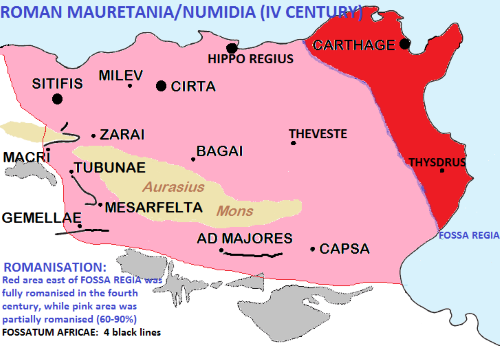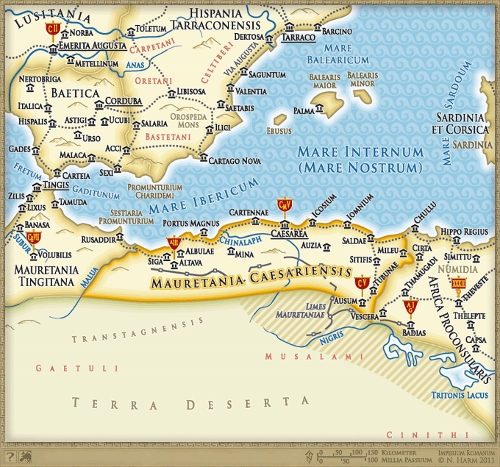 |
| Brutus and Cassius in HBO's Rome |
Language Follows Military Power
It is rather simple, language follows military conquest and economic power.
We saw the Greek language take hold in much of Egypt with the conquest by Alexander the Great. The same is true in North Africa. With the fall of Carthage to Rome in 146 BC we saw Roman military colonies and economic activity spread the Latin language along coastal Libya, Tunisia, Algeria and Morocco.
The populations of Roman North Africa that had a Romanized culture and used to speak their own variety of Latin as a result. Latin continued to be used for centuries after the fall of the Western Empire in 476 AD.
The Latin speaking local population went on during the conquest by the Germanic Vandal tribes and on into the re-conquest period by the Eastern Roman Empire.
What happened to African Latin following the Arab conquest in 696-705 AD is difficult to trace, though it was soon replaced by Arabic as the primary administrative language. At the time of the conquest a the Latin language was probably spoken in the cities and Berber languages were also spoken in the region.
 |
| Romanization of Africa in 4th century CE Red Latin, Pink 60 to 90% Latin |
 |
| North African Roman Provinces The province of Mauretania Caesariensis existed from 42 AD to the 7th Century. During and after the Fall of the Western Roman Empire in the 5th century, most of the hinterland area was lost, first to the Vandal Kingdom and later to the Mauro-Roman Kingdom, with Roman administration limited to the capital of Caesarea. . The land was reconquered by Rome during the reign of Justinian. In the late 580s, under the emperor Maurice, all of the Maghreb was granted to the Exarchate of Africa, and Mauretania Caesariensis became part of a new province, Mauretania Prima. The Muslim conquest of the Maghreb in the late 600s brought an end to Roman rule. . Over time the use of Latin would have moved closer and closer to the coast. |
 |
| Arch of Caracalla (Triumphal Arch) In Volubilis, Roman Morocco The city fell to local tribes around 285 and was never retaken by Rome because of its remoteness and indefensibility on the south-western border of the Roman Empire. It continued to be inhabited for at least another 700 years, as a Latinised Christian community. The Eastern Empire retained a small island of control on the Moroccan coast until the Arab conquest. |
Roman Military Colonies
Latin speaking Roman Africans lived in all the coastal cities of contemporary Tunisia, Western Libya, Algeria and Morocco.
The Roman Africans were generally local Berbers or Punics, but also the descendants of the populations that came directly from Rome itself or the diverse regions of the Empire as legionaries and senators.
The African province was amongst the wealthiest regions in the Empire (rivaled only by Egypt, Syria and Italy itself) and as a consequence people from all over the Empire migrated into the province. Large numbers of Roman Army veterans settled in Northwest Africa on farming plots promised for their military service.
Since the second half of the first century BC and as a result of increasing communities of Roman citizens living in the North African centers, Rome started to create colonies in North Africa.
- The main reason was to control the area with Roman citizens, who had been legionaries in many cases.
- The second reason was to give land and urban properties to the Roman military troops who had fought for the Roman Empire and so decrease the demographic problem in the Italian peninsula.
- The third reason was to facilitate the Romanization of the area and so the integration of the local Berbers -through marriage and other relationships- in the Roman Empire's social and cultural world.
 |
| Emperor Septimius Severus From Leptis Magna in the Roman province of Africa. Septimius Severus grew up in Leptis Magna. He spoke the local Punic language fluently, but he was also educated in Latin and Greek, which he spoke with a slight accent. |
Under Theodosius the area east of the Fossa regia was fully Romanized with one third of the population made of Italian colonists and their descendants. The other two thirds were Romanized Berbers, who were all Christians and nearly all Latin speaking.
Called the "Granary of the Empire", Romano-berber North Africa produced one million tons of cereals each year, one-quarter of which was exported. Additional crops included beans, figs, grapes, and other fruits. By the second century, olive oil rivaled cereals as an export item. In addition to the cultivation of slaves, and the capture and transporting of exotic wild animals, the principal production and exports included the textiles, marble, wine, timber, livestock, pottery such as African Red Slip, and wool.
Berber Africa -from northern Morocco to Tripolitania- had a population of more than 3 million inhabitants in the third century.
Nearly 40% were living in more than 500 cities. But in the sixth century -after the Byzantine reconquest- the population was reduced to less than 2.5 millions and after the Arab conquest in the eighth to tenth centuries there remained only one million.
There were 20 cities in the territory of actual Tunisia with the title and privileges of "Roman Coloniae" or similar, while in Algeria there was nearly the same amount and in Morocco and Libya only a few.
The most important was the "capital" new Carthago, with more than 300,000 inhabitants during Septimius Severus times (who enhanced Leptis Magna -where he was born- to be the second city of Berber Africa with nearly 100,000 inhabitants).
The verified "Roman Coloniae" in Africa were:
- in Africa Proconsularis: Assuras, Carpis, Carthago, Curubis, Neapolis, Simithu, Thuburnica, Madaure, Thubursicum Numidiae and Zama
- in Numidia: Cirta, Arsacal, Rusicae, Sigus, Tiddis, Verecunda, Cuicul, Masculla, Thamugadi and Theveste
- in Mauretania Caesariensis: Caesarea, Cartenna, Oppidum Novum and Rusguniae
- in Mauretania Tingitana: Volubilis, Lixus, Tingis, Banasa, Babba and Zilil
- in Mauretania Sitifensis: Auzia and Sitifis
- in Tripolitania: Leptis Magna
 |
| A mosaic on the floor ‘Labors of Hercules house’ in Volubilis, near Meknes, Morocco. |
The End of Latin
The Muslim conquest of North Africa in the late 600s and early 700s did not end Latin. Local Latin speaking communities appear to have gone on for many centuries.
Spoken Latin is attested in the city of Gabès by Ibn Khordadbeh (died 912), in Béja, Biskra, Tlemcen and Niffis by al-Bakri (died 1094) and in Gafsa and Monastir by al-Idrisi (died 1165).
The latter said of Gafsa that "its inhabitants are Berberised, and most of them speak the African Latin tongue."
The Normans, when they were acquiring their African kingdom in the 12th century, received help from the remaining Christian populations of Tunisia, and some historians argue that those Christians still spoke a Romance language.
The language existed until the arrival of the Banu Hilal Arabs in the 11th century and probably until the beginning of the fourteenth century. According to one historian, "Christian communities, generally labelled Afariqa or Ajam in the Arab sources and speaking a Latin dialect ... are known to have survived until the fourteenth century."
Virginie Prevost pinpointed that -between the Berbers of Afrikiya- the African Romance language was linked to Christianity, that survived in north Africa until the XIV century and according to the testimony of Mawlâ Aḥmad probably until the early XVIII century in Touzeur (south of Gafsa).
The Arab Mawla Ahmad wrote that in 1709 "the inhabitants of Tazeur are what remains of the Christians who were once in Afrikiya, before the Arab conquest".
 |
Click to enlarge
Languages of the Eastern Roman Empire
|
 |
| Portrait of the Roman African poet Terentius
Terentius may have been born in or near Carthage. He may have lived in the territory of the Libyan tribe called by the Romans Afri.
|
 |
| Roman Emperor Heraclius Heraclius brought an army from Latin speaking Carthage to Constantinople to overthrow the Emperor Phocas. He was crowned Caesar Flavius Heraclius Augustus in 610. |
(Roman Africans) (Languages) (African Romance)
(Kingdom of Africa) (Roman colonies)
4 comments:
it`s a kind of rememberance for the backwardness of those lands , even if colonialism is not a solution , neither to those who rule , and those to be rule for , we sensed a limbo on those lands since most of the middle age , mostly by no evolution on anything, safe , piracy , and slave trade.
after the beginning of the XIX , european states wronfully came down for land , and those lands grow on development monstly with new crops , grapes and olive oil , and after the beginning of the XX century some industry and petrol .
a constant playgroud for war , after Independence from european rulers , things are getting worse , as even europe is also growing less wealthy , and populated by wusses .
a turning point is history
civil wars and feable democraties
Is there an understanding among historians regarding why Christianity in Latin North Africa was extinguished while it survived in Egypt and the Levant? Was the persecution in Islamic North Africa fiercer than in those other regions? It seems like the Christian population of Carthage was sizable enough that you might have assumed it would have survived as a minority until modern times.
My understanding is that the church in Carthage and former Roman Africa remained in communion with Rome and Latin West after the Islamic conquest. Could it have been more forcibly suppressed on this account of this connection?
To The Obscurantist
no way
populations of christian faith went to south italy and sicily were byzantium rule kept foot on ground for a few centuries forward
in egipt only the copts remain , cause they were numerous , and didn`t like the religious path of rome or constantinople , … they got a diferent path
in levant they kept numerous numbers , and are needed to translate those ancient knowledge from greece and rome to the new islamic rulers , but they kept a instable ground on century onwards since , and are now overrun by the hizballah siite , and the sunnis too
them around 670 AD a iron curtain came down on the border between randon barbarism , and a full one
Post a Comment